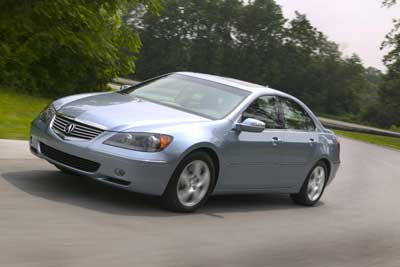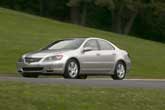Recent Articles
Popular Makes
Body Types
Hot Tech: Collision Preparedness
When a wreck is inevitable, some cars automatically prepare you for it

Driving is an emotional endeavor. It brings pleasure to the people who love it, and those enthusiasts who believe that they are more skilled than technology decry the addition of safety features that “think” for the driver. But driving depends on human skill, training, and experience, and every day thousands of people find themselves in situations for which their personal “programming” is inadequate to avoid a collision. The reality is that regular Joes benefit tremendously from safety technology that takes temporary control of a vehicle because, just as driving can bring pleasure, it can also bring pain when a mistake is made behind the wheel. In an effort to better protect people in crashes and help them to avoid an accident in the first place, automakers have made huge advances in active and passive safety technologies over the past decade, from crumple zones and multiple types of airbags to electronic braking and stability control systems. But until recently, these safety features have either reduced injury once a collision has occurred (passive safety systems) or worked to eliminate the potential for disaster (active safety systems). Before now, that horrifying no-man’s land between the loss of control and the actual accident had not been addressed. Acura, Lexus, and Mercedes-Benz are doing something about that by being the first companies to offer collision preparation systems. This technology determines when a crash is unavoidable via radar systems that “see” ahead of the car to monitor distances and closing rates. Once the car recognizes that a crash is going to occur, it readies the braking system to scrub as much speed as possible once the driver jams on the pedal and removes slack in the seatbelt while properly positioning the occupants for impact. Yet, because machines ultimately cannot take into consideration factors outside of their programming code, two of the three collision preparation systems on the market simply prepare for an impending crash rather than take corrective action without driver input. Acura’s setup is titled Collision Mitigation Braking System (CMBS), Lexus refers to its technology as the Pre-Collision System (PCS), and Mercedes-Benz calls its system Pre-Safe. We’ve had a chance to experience first-hand the Acura and Lexus systems in simulations designed to trick them into performing, but we haven’t experienced a demonstration of the Mercedes Pre-Safe system. Mercedes has enhanced Pre-Safe with the debut of the redesigned 2007 Mercedes-Benz S-Class. Based on what we’ve seen, and felt, we’re impressed. In fact, we don’t mind at all that Acura’s CMBS even does a little braking without being asked.
Acura
Acura The best part of CMBS is that it applies the brakes automatically, so that if the driver has suffered a medical problem and can no longer operate the vehicle the RL will slow down as much as possible before impact. Acura is the third automaker to offer collision preparation technology, featuring it on the top-of-the-line 2006 RL sedan. Dubbed the Collision Mitigation Braking System (CMBS), it’s teamed with a millimeter-wave radar unit mounted behind the Acura symbol in the grille, which monitors the distance between the RL and objects in front of the car, as well as closing rates. CMBS then determines if a frontal collision is likely to occur. The system scans up to 330 feet in front of the car, and works at speeds above 10 mph. CMBS operates in three stages. In the first two stages, which are non-critical situations where the driver can still avoid a collision, the system uses audible and visual alerts to inform the driver that the RL is closing on an object more rapidly than is safe. In stage one, the RL beeps and flashes a “brake” warning in the gauge display. In stage two, the RL repeats the audible and visual warnings, while also pre-tensioning the driver’s seatbelt and automatically applying light braking to reduce speed. In stage three, things get more serious. CMBS continues audible and visual warnings, but now pre-tensions the front passenger’s seatbelt and automatically applies harder braking to scrub as much speed as possible before impact. Note, however, that Acura warns the system is not designed to bring the RL to a halt. For that, the driver must step on the brakes. CMBS can pass through all three stages quickly, or can transition slowly, depending on the RL’s closing rate with a moving or stationary object. We learned first-hand how effective CMBS is during a demonstration drive designed to fool the system into thinking that a collision was about to occur. By driving parallel to an Acura MDX with an object hanging off the side of the SUV, we were able to engage all three stages of CMBS. Though the audible alert’s is somewhat intrusive, the system works subtly and smoothly. Even in stage three, when the seatbelts tighten up and the braking system is engaged, it works with an unbelievable degree of refinement. But the best part of CMBS is that it applies the brakes automatically, so that if the driver has suffered a medical problem and can no longer operate the vehicle the RL will slow down as much as possible before impact. Lexus and Mercedes systems don’t make a move without driver intervention. CMBS is currently offered only on the RL with the Technology Package, bundled with an active cruise control system and Michelin PAX run-flat tires, which commands an estimated premium of $4,000 over the standard model. Acura plans to equip about 10 percent of all 2006 RLs with this package.

Lexus
Lexus When PCS activates, the seatbelts snap into action, cinching your body tight against the seat, while the brake assist system feels like it’s tossed an anchor out of the trunk the moment your foot jams down on the brake pedal. Lexus’ Pre-Collision System (PCS analyzes data from the optional Dynamic Radar Cruise Control system and combines it with information on vehicle speed, steering angle, and yaw rate. After analysis is performed, the computer determines if a crash is about to happen and, if necessary, immediately activates the pre-tensioning front seatbelts, drawing the belts tightly against the occupants and snugging them tight against the seatbacks. PCS also readies the brake assist feature to apply full braking power and reduce speed as much as possible before impact to minimize the amount of force that might reach the passenger compartment. On vehicles with Adaptive Variable Suspension (AVS), the PCS also reduces nose dive to make more efficient use of the brake assist system. To let us experience PCS first-hand, Lexus engineers crafted a lightweight, deformable barrier that looked like it was covered in aluminum foil and which wouldn’t damage the car upon impact but would trick the safety feature into activating. It took several passes in a Lexus GS 430 to get PCS to work, but that was mainly because in this safe, controlled environment we weren’t easily able to replicate the panicked motions of a driver about to do serious sheet metal damage. But when the system finally did perform its trick, it responded powerfully, instantaneously, and impressively. When PCS activates, the seatbelts snap into action, cinching your body tight against the seat, while the brake assist system feels like it’s tossed an anchor out of the trunk the moment your foot jams down on the brake pedal. Once the GS shuddered to a stop, the shiny barrier rolling around in front of it like a fallen alien pedestrian, the seatbelts whirred, clicked, and released, freeing us to make another pass for more and . The system reacts more violently than Acura’s CMBS, but it also operates only when a collision is going to occur, rather than when one might occur. We only wish Lexus included some kind of automatic braking feature like the Acura. PCS requires the optional Dynamic Radar Cruise Control system and is available on the Lexus GS 300 and GS 430 for $2,850. On the Lexus LS 430, PCS is bundled with the $8,185 Custom Luxury package or the $13,570 Ultra Luxury package. That’s a pricey insurance policy, especially when Lexus currently has very little real-world data to support the theory that it can save lives.

Mercedes-Benz
Mercedes-Benz The Mercedes Pre-Safe system prepares occupants and vehicle safety technology for a collision. Mercedes-Benz was the first automaker to debut collision preparation technology in 2002, but has been working on such systems for two decades. The first fruits of the company’s labor appeared as protective roll hoops for the 1989 SL roadster, which exploded into place behind the rear seats in the event of a rollover accident. Today, the SL continues to offer this protective device, as well as the CLK cabriolet. In fact, we’ve experienced this roll hoop deployment personally, while tooling along the Pacific Coast Highway near Big Sur, where rapid speed on a twisty road with sudden elevation changes caused a current-generation SL to figure we were about to do something stupid. We haven’t seen Pre-Safe in action, but it works similarly to those developed by Acura and Lexus, with subtle but effective differences. Like the competitors’ systems that came after it, Pre-Safe relies on radar to work, but uses two beams rather than one to determine the rate of approach of objects in front of the vehicle. When Pre-Safe determines that a collision is imminent, it removes slack from the seatbelts by activating the pre-tensioners, and readies the brake assist system to activate full braking pressure when the driver jams on the pedal. But Pre-Safe goes a couple of steps further. If the front passenger’s seat or the rear power seats are reclined, moved too far forward, or otherwise out of optimum placement for protection, they are automatically moved into a more favorable position. Pre-Safe will also close the sunroof if the vehicle skids, since a skid is often a precursor to a rollover accident. Currently, Pre-Safe is offered on the flagship S-Class sedan, where it is standard on every model, from the $65,675 S350 to the $169,775 S65 AMG. When the all-new 2007 Mercedes-Benz S-Class debuts, Pre-Safe gets enhancements that will close any open side windows to make better use of side curtain airbags, and will inflate special seat cushions to position occupants properly before impact. There is no plan to offer automatic braking, like Acura’s CMBS.
Photos courtesy of the Manufacturers
